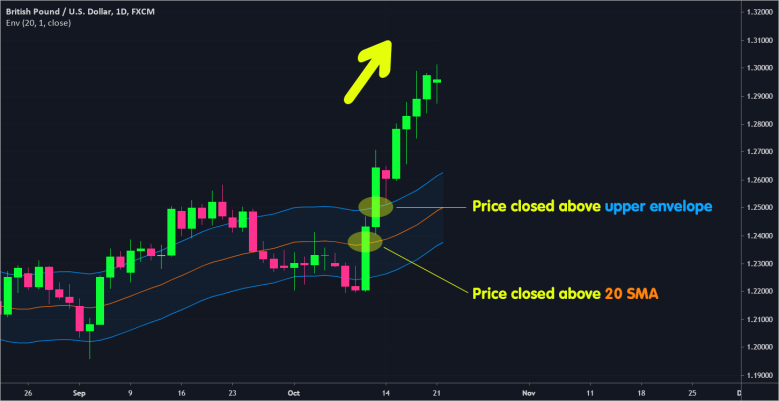Moving Average Envelopes

Moving Average Envelopes: Learn How Clever Traders Use Them
Moving Average Envelopes are a popular tool used by traders to understand and analyze market trends. In simple terms, they are lines drawn above and below a moving average to create a range, helping traders identify potential buy and sell signals. Let’s break it down to understand how these envelopes work and how savvy traders utilize them.
What Are Moving Average Envelopes?
Moving Average Envelopes consist of two lines that are placed above and below a simple moving average (SMA) or an exponential moving average (EMA). These lines are set at a certain percentage distance from the moving average.
- Upper Envelope: This line is drawn at a set percentage above the moving average.
- Lower Envelope: This line is drawn at the same percentage below the moving average.
The percentage can be adjusted based on market volatility, and traders usually set it between 1-3%. The concept is straightforward: when the price moves beyond the envelope, it may indicate an overbought or oversold condition.
How Do Moving Average Envelopes Work?
Here’s how Moving Average Envelopes can be interpreted:
- Trend Identification:
- Uptrend: When the price stays above the moving average and occasionally touches or breaks the upper envelope.
- Downtrend: When the price stays below the moving average and sometimes touches or breaks the lower envelope.
- Buy and Sell Signals:
- Buy Signal: If the price drops to or below the lower envelope, it might be a good time to buy, anticipating a bounce back to the moving average.
- Sell Signal: If the price rises to or above the upper envelope, it might be a signal to sell, expecting a drop back to the moving average.
- Volatility Analysis:
- Wider envelopes indicate higher volatility, while narrower envelopes suggest lower volatility.
Why Do Clever Traders Use Moving Average Envelopes?
Moving Average Envelopes are popular among experienced traders for several reasons:
- Simple to Use: They offer a straightforward way to visualize market trends and potential reversal points.
- Versatility: They can be applied to any asset class, including stocks, forex, and commodities.
- Trend Confirmation: Envelopes help confirm existing trends and identify potential reversal points.
- Customizable: Traders can adjust the percentage distance based on their risk tolerance and market conditions.
Example: Using Moving Average Envelopes
Imagine you are analyzing the stock of Company XYZ. You apply a 20-day Simple Moving Average (SMA) with a 2% envelope.
- Upper Envelope: SMA + 2%
- Lower Envelope: SMA – 2%
Scenario 1: The Price Breaks Above the Upper Envelope
- Interpretation: The stock might be overbought, indicating a potential reversal or pullback. Savvy traders might consider selling or shorting.
Scenario 2: The Price Dips Below the Lower Envelope
- Interpretation: The stock might be oversold, signaling a potential rebound. Clever traders might see this as a buying opportunity.
Adjusting Envelopes for Different Markets
Different markets have varying volatility levels. Here’s how traders adjust envelopes:
- Stocks: Typically use a 2-5% envelope due to moderate volatility.
- Forex: Often uses a 0.5-2% envelope because of high liquidity and lower volatility.
- Commodities: May require wider envelopes, like 3-10%, because of high price fluctuations.
Common Strategies with Moving Average Envelopes
Here are some strategies clever traders use with Moving Average Envelopes:
- Breakout Strategy:
- When the price consistently stays outside the envelopes, it might indicate a strong breakout. Traders look for confirmation before entering a trade in the breakout direction.
- Reversal Strategy:
- When the price touches the envelopes, it may suggest a reversal. Traders might use this as a signal to enter a trade in the opposite direction.
- Trend-Following Strategy:
- Traders use envelopes to stay with the trend. As long as the price remains between the envelopes, they maintain their position, only exiting if a breakout or reversal is confirmed.
Advantages of Moving Average Envelopes
- Clarity: They provide clear visual signals for entry and exit points.
- Trend Analysis: Useful for both trending and range-bound markets.
- Flexible: Can be tailored to different market conditions.
Limitations of Moving Average Envelopes
- False Signals: In choppy markets, envelopes might produce false signals.
- Lagging Indicator: Like all moving averages, they can lag behind price action, leading to late entries or exits.
Conclusion
Moving Average Envelopes are a powerful tool for traders seeking to understand market trends and potential reversals. By incorporating these envelopes into their strategies, clever traders can make more informed decisions, potentially increasing their success in the market.
By adjusting the envelopes’ percentages and combining them with other technical indicators, traders can enhance their trading strategies and adapt to various market conditions, making Moving Average Envelopes a versatile and essential part of any trader’s toolkit.
After going over a few of the articles on your site, I seriously appreciate your way of blogging. I book-marked it to my bookmark webpage list and will be checking back in the near future. Take a look at my website as well and tell me your opinion.